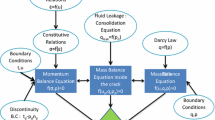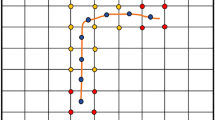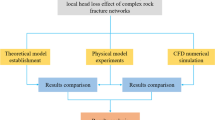Abstract
The objective of this paper is to study the effect of rock anisotropy on the initiation and propagation of fracture driven by fluid. For this purpose, an improved hydromechanical model considering rock structural anisotropy is established in the framework of the particle flow simulation by assuming that the anisotropic rocks are characterized by a matrix phase with non-persistent weak layers embedded. In this model, the mechanical behavior of rock matrix is described by bond contact while that of weak layers by smooth joint contact, and the fluid flow is reproduced through a new aperture evolution model of pipes redefined according to contact types and orientations. After the calibration of model’s parameters, the effectiveness of proposed model is assessed with the help of a typical case of fluid driven fracture around a borehole. The proposed model can successfully describe the local stress anisotropy and fracture reoriented propagation around borehole due to fluid injection. Some additional numerical simulations with different confining stress are also conducted for the typical case. Moreover, a series of sensitive analysis is further realized to investigate effects of inherent rock anisotropy including elastic, strength and permeability on the initiation and propagation of fractures.





















Similar content being viewed by others
References
Al-Busaidi A, Hazzard J, Young R (2005) Distinct element modeling of hydraulically fractured lac du bonnet granite. J Geophys Res: Solid Earth 110:B06302
Amadei B (1996) Importance of anisotropy when estimating and measuring in situ stresses in rock. Int J Rock Mech Min Sci 33:293–325
Ambrose J, Zimmerman R, Suarez-Rivera R (2014) Failure of shales under triaxial compressive stress. In: The 48th U.S. rock mechanics/geomechanics symposium. American Rock Mechanics Association
Biot MA (1941) General theory of three-dimensional consolidation. J Appl Phys 12:155–164
Bybee K (2009) Proper evaluation of shale-gas reservoirs leads to more-effective hydraulic-fracture stimulation. J Pet Technol 61:59–61
Chong Z, Karekal S, Li X, Hou P, Yang G, Liang S (2017) Numerical investigation of hydraulic fracturing in transversely isotropic shale reservoirs based on the discrete element method. J Nat Gas Sci Eng 46:398–420
Cormery F, Welemane H (2007) A critical review of some damage models with unilateral effect. Mech Res Commun 29:391–395
Cundall PA, Strack ODL (1979) A discrete numerical model for granual assemblies. Geotechnique 29:47–65
Duan K, Kwok CY, Wu W, Jing L (2018) Dem modeling of hydraulic fracturing in permeable rock: influence of viscosity, injection rate and in situ states. Acta Geotech 13:1187–1202
Fjær E, Nes OM (2014) The impact of heterogeneity on the anisotropic strength of an outcrop shale. Rock Mech Rock Eng 47:1603–1611
Gan Q, Elsworth D, Alpern J, Marone C, Connolly P (2015) Breakdown pressures due to infiltration and exclusion in finite length boreholes. J Pet Sci Eng 127:329–337
Guo T, Zhang S, Qu Z, Zhou T, Xiao Y, Gao J (2014) Experimental study of hydraulic fracturing for shale by stimulated reservoir volume. Fuel 128:373–380
Haddag B, Abed-Meraim F, Balan T (2009) Strain localization analysis using a large deformation anisotropic elastic-plastic model coupled with damage. Int J Plast 25:1970–1996
Haimson B (2007) Micromechanisms of borehole instability leading to breakouts in rocks. Int J Rock Mech Min Sci 44:157–173
Haimson B, Fairhurst C, Fairhurst C (1967) Initiation and extension of hydraulic fractures in rocks. Soc Pet Eng J 7:310–318
Kirsch C (1898) Die theorie der elastizitat und die bedurfnisse der festigkeitslehre. Ztschr Vernes Deutsch Ing 42:797–807
Krzaczek M, Nitka M, Kozicki J, Tejchman J (2020) Simulations of hydro-fracking in rock mass at meso-scale using fully coupled DEM/CFD approach. Acta Geotech 15:297–324
Li Z, Li L, Li M, Zhang L, Tang C (2017) A numerical investigation on the effects of rock brittleness on the hydraulic fractures in the shale reservoir. J Nat Gas Sci Eng 50:22–32
Liu Z, Chen M, Zhang G (2014) Analysis of the influence of a natural fracture network on hydraulic fracture propagation in carbonate formations. Rock Mech Rock Eng 47:575–587
Meier T, Rybacki E, Reinicke A, Dresen G (2013) Influence of borehole diameter on the formation of borehole breakouts in black shale. Int J Rock Mech Min Sci 62:74–85
Miehe C, Schaenzel LM, Ulmer H (2015) Phase field modeling of fracture in multi-physics problems. Part I. Balance of crack surface and failure criteria for brittle crack propagation in thermo-elastic solids. Comput Methods Appl Mech Eng 294:449–485
Moghaddam RN, Jamiolahmady M (2016) Fluid transport in shale gas reservoirs: simultaneous effects of stress and slippage on matrix permeability. Int J Coal Geol 163:87–99
Niandou H, Shao J, Henry J, Fourmaintraux D (1997) Laboratory investigation of the mechanical behaviour of tournemire shale. Int J Rock Mech Min Sci 34:3–16
Oliver J (1996) Modelling strong discontinuities in solid mechanics via strain softening constitutive equations, part 1: fundamentales. Int J Numer Methods Eng 39:3575–3600
Park B, Min KB (2015) Bonded-particle discrete element modeling of mechanical behavior of transversely isotropic rock. Int J Rock Mech Min Sci 76:243–255
Potyondy ADO, Cundall BPA (2004) A bonded-particle model for rock. Int J Rock Mech Min Sci 41:1329–1364
Shimizu H, Murata S, Ishida T (2011) The distinct element analysis for hydraulic fracturing in hard rock considering fluid viscosity and particle size distribution. Int J Rock Mech Min Sci 48:712–727
Tan P, Jin Y, Han K, Hou B, Chen M, Guo X, Gao J (2017) Analysis of hydraulic fracture initiation and vertical propagation behavior in laminated shale formation. Fuel 206:482–493
Wang T, Zhou W, Chen J, Xiao X, Li Y, Zhao X (2014) Simulation of hydraulic fracturing using particle flow method and application in a coal mine. Int J Coal Geol 121:1–13
Warpinski NR, Mayerhofer MJ, Vincent MC, Cipolla CL, Lolon EP (2009) Stimulating unconventional reservoirs: Maximizing network growth while optimizing fracture conductivity. J Can Pet Technol 48:39–51
Zeng QD, Yao J, Shao JF (2018) Numerical study of hydraulic fracture propagation accounting for rock anisotropy. J Pet Sci Eng 160:422–432
Zeng QD, Yao J, Shao JF (2019) Study of hydraulic fracturing in an anisotropic poroelastic medium via a hybrid EDFM-XFEM approach. Comput Geotech 105:51–68
Zhang F, Damjanac B, Huang H (2013) Coupled discrete element modeling of fluid injection into dense granular media. J Geophys Res: Solid Earth 118:2703–2722
Zhang F, Wang T, Liu F, Peng M, Bate B, Wang P (2022) Hydro-mechanical coupled analysis of near-wellbore fines migration from unconsolidated reservoirs. Acta Geotech 17:3535–3551
Zhang Q, Zhang XP, Sun W (2020) Hydraulic fracturing in transversely isotropic tight sandstone reservoirs: a numerical study based on bonded-particle model approach. J Struct Geol 136:104068
Zhang X, Wang JG, Gao F, Ju Y, Liu J (2017) Impact of water and nitrogen fracturing fluids on fracturing initiation pressure and flow pattern in anisotropic shale reservoirs. Comput Geotech 81:59–76
Zhang Y, Liu Z, Han B, Zhu S, Zhang X (2022) Numerical study of hydraulic fracture propagation in inherently laminated rocks accounting for bedding plane properties. J Pet Sci Eng 210:109798
Zhang Y, Shao J, Liu Z, Shi C (2021) An improved hydromechanical model for particle flow simulation of fractures in saturated rocks. Int J Rock Mech Min Sci 147:104870
Zhang Y, Shao J, Liu Z, Shi C, De Saxcé G (2018) Effects of confining pressure and loading path on deformation and strength of cohesive granular materials: a three-dimensional dem analysis. Acta Geotech 14:443–460
Zhang Y, Shao J, de Saxcé G, Shi C, Liu Z (2019) Study of deformation and failure in an anisotropic rock with a three-dimensional discrete element model. Int J Rock Mech Min Sci 120:17–28
Zhao LY, Shao JF, Zhu QZ (2018) Analysis of localized cracking in quasi-brittle materials with a micro-mechanics based friction-damage approach. J Mech Phys Solids 119:163–187
Zhou J, Luqing Z, Zhejun P, Zhenhua H (2016) Numerical investigation of fluid-driven near-borehole fracture propagation in laminated reservoir rock using pfc2d. J Nat Gas Sci Eng 36:719–733
Zhu QZ, Kondo D, Shao JF (2008) Micromechanical analysis of coupling between anisotropic damage and friction in quasi brittle materials: role of the homogenization scheme. Int J Solids Struct 45:1385–1405
Zisser N, Nover G (2009) Anisotropy of permeability and complex resistivity of tight sandstones subjected to hydrostatic pressure. J Appl Geophys 68:356–370
Zoback M, Rummel F, Jung R, Raleigh CB (1977) Laboratory hydraulic fracturing experiments in intact and pre-fractured rock. Int J Rock Mech Min Sci Geomech Abstr 14:49–58
Acknowledgments
This study has been jointly supported by the State Key RD Program of China (Grant No. 2017YFC1501100), China Postdoctoral Science Foundation (Grant No. 2019TQ0080, Grant No. 2020M671320), and the Key Laboratory of Ministry of Education on Safe Mining of Deep Metal Mines (Grant No. DM2019K02).
Author information
Authors and Affiliations
Corresponding author
Additional information
Publisher's Note
Springer Nature remains neutral with regard to jurisdictional claims in published maps and institutional affiliations.
Rights and permissions
Springer Nature or its licensor holds exclusive rights to this article under a publishing agreement with the author(s) or other rightsholder(s); author self-archiving of the accepted manuscript version of this article is solely governed by the terms of such publishing agreement and applicable law.
About this article
Cite this article
Zhang, Y., Shao, J., Zhu, S. et al. Effect of rock anisotropy on initiation and propagation of fractures due to fluid pressurization. Acta Geotech. 18, 2039–2058 (2023). https://doi.org/10.1007/s11440-022-01703-5
Received:
Accepted:
Published:
Issue Date:
DOI: https://doi.org/10.1007/s11440-022-01703-5




